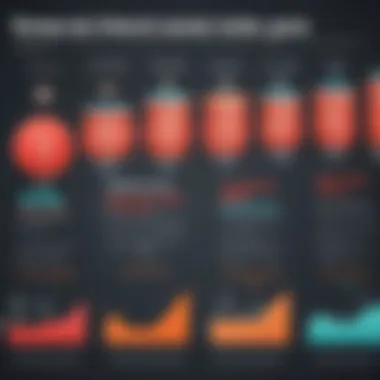Understanding the Impact of Stimulus Checks


Intro
Stimulus checks have emerged as a significant component of modern economic policy, especially during times of crisis. These payments, often distributed by government entities, are designed to put a bit of extra cash in individuals' pockets. The implications of these checks stretch far beyond immediate relief; they have myriad influences on the economy, spending habits, and even societal structures. By unpacking the history, mechanics, and outcomes surrounding stimulus checks, we can glean valuable insights that may help shape future policies.
The context in which stimulus checks are deployed is crucial for understanding their effectiveness. Historically, these financial aids have been implemented in response to economic slowdown, high unemployment, or other significant societal challenges. The action of issuing such checks not only reflects a government’s intention to support its citizens but also serves as a mechanism for stimulating economic activity. As we navigate through the nuances of stimulus checks, we will discuss key concepts that define their role in financial recovery and examine their long-term implications on both individuals and the economy at large.
By analyzing policy decisions, spending behaviors, and societal reactions, readers will develop a more nuanced understanding of what stimulus checks signify. In this article, we will explore the interplay of various factors that contribute to their success or failure, providing a comprehensive perspective on an essential aspect of economic recovery.
Investment Dictionaries
Key Financial Terms
In any discussion surrounding stimulus checks, certain financial terms come to the forefront. Here are a few pivotal terms commonly associated with these payments:
- Fiscal Policy: Refers to government spending and tax policies aimed at influencing economic conditions, often utilized to stimulate growth during recessions.
- Monetary Policy: Actions taken by a central bank to manage the money supply and interest rates, which can complement fiscal measures.
- Inflation: The rate at which the general level of prices for goods and services rises, eroding purchasing power. Stimulus checks can impact inflation rates depending on how they influence consumer spending and demand.
- Economic Recovery: The phase wherein the economy begins to grow after a period of contraction. Understanding how stimulus checks fit into this phase is crucial for comprehending their broader implications.
Investment Strategies Explained
Investing strategies can often get complicated, but understanding how stimulus checks influence these strategies is crucial for financial health, especially for individuals managing personal investments or businesses.
- Consumer Spending Increase: Stimulus checks typically lead to an uptick in consumer spending, which can benefit businesses and investment opportunities. This change can be a signal for investors to look for stocks in sectors like retail, travel, and entertainment.
- Market Perception: Investors must be mindful of how the issuance of checks may affect market sentiment. Positive consumer reactions can lead to bullish market trends, whereas skepticism about the long-term impact can create volatility.
- Diversification: With stimulus checks creating temporary purchasing power, investors might reconsider their strategies regarding asset classes. More disposable income can lead to changes in expenditure patterns, influencing diverse investment avenues.
"Stimulus checks not only provide immediate support but also spark broader economic conversations about recovery and future resilience."
In summary, understanding key financial terms and investment strategies related to stimulus checks equips individuals and organizations with the insight needed to navigate both immediate and long-term financial landscapes. Moving forward, it will be essential to articulate the distinct phases through which stimulus checks have evolved and assess their lasting impact on both personal finance and broader economic conditions.
Intro to Stimulus Checks
In today’s shifting economic landscape, the concept of stimulus checks has quantum leaped into public discourse. Their significance goes beyond mere monetary transfers; they represent government intervention during crises, reflecting a crucial mechanism for addressing economic downturns and maintaining consumer confidence. As we delve into this topic, it’s vital to understand that stimulus checks, while sometimes seen as a quick fix, carry with them a host of implications that resonate through various sectors of society.
Definition and Purpose
Stimulus checks, often referred to as economic impact payments, are direct payments made by the government to individuals to stimulate economic activity. The primary aim of these payments is to bolster spending when consumer confidence lags during economic tumult, such as recessions or emergencies. Essentially, these payments aim to put cash in people's hands, with the hope that they will spend it—thereby driving demand for goods and services and supporting businesses.
The checks often hinge on a few key criteria including income level and family size, which act more like a lifeline during dire moments, helping households settle bills or invest in necessities. While their immediate purpose seems straightforward—kicking up consumption and preventing further economic decline—the broader implications are worth exploring.
Historical Overview
The concept of direct financial assistance from the government isn’t exactly new, but it gained real traction during the Great Depression. Back then, families faced economic hardship that seemed relentless. The government responded through various relief programs, but it wasn’t until the 2008 financial crisis that stimulus checks were again considered effective instruments for recovery.
Fast forward to 2020, amidst the COVID-19 pandemic, stimulus checks took center stage once more. These payments aimed not only to provide relief for sudden job losses or business closures, but also to help stabilize the economy. In a world where traditional safety nets seemed inadequate, the resurgence of these checks has reignited discussions about their role in modern fiscal policy.
This historical lens sheds light on how governments have tailored stimulus checks to meet the needs of the times, often adapting policies based on economic conditions and challenges. The evolution speaks volumes about their perceived effectiveness and potential drawbacks, something which will be explored in deeper detail in the following sections.
Key Components of Stimulus Checks
Understanding the key components of stimulus checks is crucial for grasping their overall impact on both the economy and society. These financial aids provided during specific economic crises are designed not just to alleviate immediate financial burdens but to stimulate broader economic activity. Let's break this down into three essential sections.
Eligibility Criteria
Eligibility is possibly one of the most critical aspects of stimulus checks. It determines who will receive the funds and ensures that those who need assistance the most are recognized. To qualify for these checks, several factors typically come into play:
- Income Levels: Often, stimulus checks are primarily targeted at individuals or households with income below a certain threshold. For instance, during the COVID-19 pandemic, single filers earning up to $75,000 were eligible for full checks, with phased reductions for higher incomes.
- Tax Filing Status: The criteria usually depend on whether individuals file taxes jointly or separately. Couples who filed together typically received more substantial relief compared to those filing alone, reflecting a strategic choice by policymakers to support families.
- Dependents: Many programs allow for checks to consider dependents, extending benefits to families with children. This encourages spending power across various household structures and addresses specific needs.
- Citizenship: In many programs, only U.S. citizens and some qualified non-citizens are eligible. This aspect has sparked considerable debates about fairness and inclusiveness.
Eligibility criteria are essential in balancing the need for speedy aid while addressing fairness in distribution.


Distribution Mechanisms
How stimulus checks are distributed is another pivotal element in their effectiveness. The goal is not just to provide funds but to do so in a manner that ensures swift and widespread accessibility. Here are some prevalent distribution methods:
- Direct Deposits: This is often the fastest method, allowing funds to be transferred into bank accounts of eligible recipients within a short period. For example, during the COVID-19 pandemic, many received their checks within days of policy announcements through this method.
- Physical Checks: For those without bank accounts or those who opted out of direct deposit, physical checks can be mailed. However, this method tends to delay the process and may lead to issues like checks being lost or delayed in the mail.
- Prepaid Debit Cards: In some cases, recipients may receive funds on prepaid debit cards, which can be used for purchases or withdrawn as cash. This alternative caters to those who may not have banking resources available.
- Distribution via Taxation Systems: Some checks are distributed through existing tax systems, using adjusted figures from previous tax returns to determine eligibility and amounts.
While each method has its advantages and disadvantages, comprehensively understanding these mechanisms highlights how efficiently aid can reach those in need.
Amounts Allocated
The amounts allocated through stimulus checks are determined by various economic factors, including perceived needs, economic conditions, and political considerations. These amounts can vary significantly:
- Initial Amounts: The checks issued during the Great Recession were considerably lower compared to those issued during the COVID-19 crisis, reflecting shifts in economic philosophy. For example, the first round of COVID-19 checks provided $1,200 for eligible individuals, a stark contrast to the initial $600 typical during previous crises.
- Adjusting for Inflation: It's also essential to discuss how amounts are influenced by inflation. Keeping the purchasing power stable is crucial for ensuring the checks have the intended effect on stimulating the economy.
- Incentives for Spending: The design of these amounts can also impact consumer behavior. A higher amount might encourage more immediate spending, while lower amounts could lead to saving behavior during uncertain times.
- Consequential Adjustments: Policymakers often reassess amounts based on economic feedback, adjusting future checks to better address ongoing conditions.
In summary, the amounts allocated reflect underlying economic challenges and strategies to stimulate growth, influencing how recipients respond and what impact the checks ultimately have on the economy.
"The effectiveness of stimulus checks largely hinges on these core components, shaping the broader narrative of economic recovery and household stability."
Economic Rationale Behind Stimulus Checks
The deployment of stimulus checks serves as a significant tool in economic policy, often designed to offer immediate relief in times of financial distress. Understanding the economic rationale behind stimulus checks is vital for comprehending their effectiveness and potential shortcomings. This section addresses the various elements that structure their purpose, intrinsic benefits, and considerations.
Macroeconomic Goals
Stimulus checks are often aimed at achieving specific macroeconomic goals. These aims typically involve:
- Boosting Aggregate Demand: When individuals receive cash directly, they are more likely to spend it on basic needs which increases overall consumption in the economy. This demand spike is crucial in times of recession when consumer spending tends to taper off.
- Stabilizing Economic Growth: By injecting liquidity into the economy, stimulus checks help stabilize growth trajectories during downturns. Governments rely on these payments not only to bolster spending but also to restore consumer confidence.
- Reducing Unemployment: Economic theory posits that stimulating demand can lead to job growth. Those employed in consumer-driven sectors, such as retail, are directly impacted by increased spending, which can lead to hiring or retaining staff.
It’s important to note that while the immediate effects are often favorable, long-term dependency can morph some of these benefits into challenges. Increasing reliance on government intervention may hamper self-sustained growth in the long run.
Impact on Consumption
The direct disbursement of funds through stimulus checks has significant implications for consumer behavior. Understanding these impacts involves examining several dimensions:
- Immediate Spending Dilemmas: Recipients of stimulus checks typically face choices that center around urgent needs, like paying bills or purchasing groceries. According to research conducted during the COVID-19 pandemic, many used the funds for essential expenses rather than luxury items. This suggests that stimulus checks can have a profound impact on day-to-day living standards.
- Consumer Confidence: The psychological effects of receiving stimulus checks can lead to increased optimism among consumers. When individuals feel financial support from the government, it often translates into higher spending, which is vital for economic recovery. A disposable income that encourages spending can also uplift morale during bleak times.
- Disparities in Spending Patterns: Not all groups respond similarly to stimulus checks. Lower-income households tend to spend a higher percentage of their checks compared to wealthier counterparts. This behavior can exacerbate income disparities, particularly if wealthier individuals save their stimulus funds rather than spend them.
"Cash on hand speaks loudest, especially in moments of crisis; whether it translates to long-term growth is where debates often ignite."
The ripple effect of stimulus checks on consumption highlights the complexity of economic incentives. Policymakers must weigh these immediate benefits against broader implications for inflation and economic stability, making a thorough understanding of consumer behavior critical in assessing the rationale behind stimulus checks.
Phases of Stimulus Checks in the United States
The phases of stimulus checks in the United States provide a rich historical narrative on how the government has responded to economic challenges. It's crucial to understand these phases because they reflect a series of policy decisions aimed at curbing economic decline and assisting citizens in hardship. Each phase reveals the evolution of governmental strategy to tackle pressing financial issues.
The Great Recession Response
In the late 2000s, the U.S. economy found itself in a tailspin, largely due to the housing market collapse and subsequent financial crisis. The government’s response included stimulus payments to encourage consumer spending and stabilize households. This initiative primarily aimed at restoring confidence and providing a financial cushion.
The Economic Stimulus Act of 2008 was a key piece of legislation during this phase, resultng in one-time payments to eligible individuals and couples. Whereas singles received $600 and married couples got $1,200, there were additional amounts for dependents as well. The rationale was straightforward: if individuals had extra cash, they might spend it, which in turn would stimulate economic activity.
Critics argued these checks fell short. Some debated their long-term effectiveness in recovery, while others noted that the payments did not adequately address systemic issues. Yet, as a temporary lifeline, they provided immediate benefits and relief for those struggling to stay afloat.
COVID-19 Relief Efforts
Fast forward to 2020, and the world was confronted with the COVID-19 pandemic. The economic impact was severe, leading to swift governmental action. The Coronavirus Aid, Relief, and Economic Security (CARES) Act introduced a series of stimulus checks intended to support both individuals and the economy as a whole. This time, the checks were more substantial—ranging from $1,200 for individuals and $2,400 for married couples, plus $500 for each qualifying child.


This phase showcased the government’s ability to pivot quickly in response to an unprecedented crisis. The payments reached millions of Americans and were designed to offset the loss of income for those out of work. According to reports, these checks succeeded in providing financial relief and preventing millions of households from slipping into poverty. Importantly, the swift distribution of funds through direct deposit and checks represented a major logistical feat, allowing for timely economic stimulation.
Despite the benefits, challenges remained. Reports indicated that many people faced delays receiving their payments, while others were ineligible due to income thresholds.
Comparative Responses by Different Administrations
Examining the responses by different administrations reveals how political ideologies shape economic policy. During the Great Recession, the Bush administration leaned into direct payments, focusing on consumer spending as a way to spur recovery. In contrast, the Obama administration soon followed with initiatives like the American Recovery and Reinvestment Act, which included stimulus checks but coupled them with broader investments in infrastructure and education.
When COVID-19 emerged, the Trump administration approved the CARES Act after financial concerns became evident. This was a swift decision to address immediate needs with checks and unemployment benefits. However, differences in approach came again with the Biden administration, which not only extended benefits but also pushed for the American Rescue Plan, ensuring more direct aid to those most affected.
This shifting landscape suggests that while the fundamental principle of direct payments has remained, strategies have differed vastly in execution and intent.
"The history of stimulus checks shows not just economic response but also reflects societal values and priorities"
Each phase of stimulus checks provides critical insights into how the government views its role in economic stability and recovery. Past actions underline ongoing discussions about the effectiveness of such financial support and its potential role in future economic policy.
Social Implications of Stimulus Checks
The topic of social implications surrounding stimulus checks is a crucial element of this article. It brings to light the broader effects these financial aids have on community dynamics, individual behavior, and the larger fabric of society. Understanding how stimulus checks impact households opens a window to assess their role not just as a short-term relief measure, but as a facilitator of social change and stability.
Impact on Household Economies
When folks receive stimulus checks, the immediate thought is often about groceries or bills. It’s a lifeline for many, especially during challenging financial times. Studies indicate that these funds provide a buffer for families, allowing them to address urgent financial obligations. For instance, take a working-class family who may be struggling with rent or medical expenses. The influx of cash from a stimulus can mean the difference between being behind on payments or meeting their obligations.
These checks also ripple outwards, affecting local businesses. When families spend their stimulus funds at local shops, this creates a boost in economic activity. For instance, restaurants or grocery stores often see an uptick in sales, which contributes to stabilizing the local job market.
Additionally, households that receive these payments can invest in essentials, education, or even create savings. This leads to long-term financial stability, fostering wealth accumulation over generations.
- Benefits of Stimulus on Household Economies:
- Enhanced cash flow for urgent expenses
- Increased spending in local businesses
- Potential for savings and investment
However, this isn’t a universal experience. Some families may choose not to spend, leading to concerns over hoarding or stockpiling. This behavior can stem from uncertainty or fear about the economy, resulting in a varied impact across different demographics.
Psychological Effects on Recipients
The psychological landscape of recipients of stimulus checks is equally intricate. These payments can produce a sense of relief, enabling families to breathe easier, if only for a moment in time. Imagine receiving that check after weeks of worry; it can feel like a weight lifted off one’s shoulders. It's not just about monetary relief, but also about restoring a semblance of control over financial situations.
However, there’s another side to this coin. For some, the reliance on government assistance can lead to feelings of shame or embarrassment. Being in a position to need help isn't something that everyone is comfortable with, even if the assistance is well-earned. This can lead to mixed feelings, where joy from receiving help is paired with the stigma of needing aid.
The psychological effects can lead to a variety of outcomes, such as:
- Positive Response:
- Negative Response:
- Relief and reduced anxiety
- Enhanced household morale
- Increased community engagement
- Feelings of shame or inadequacy
- Anxiety regarding future financial stability
- Negative perceptions of government support
In many ways, understanding the social implications of stimulus checks is as much about emotional well-being as it is about economic solvency. The interplay of these factors can influence not just individual families, but entire neighborhoods and communities, shaping the collective social psychology as individuals navigate their financial realities.
Critiques and Challenges
Discussing critiques and challenges surrounding stimulus checks is essential to grasp their multifaceted impact on the economy and society. While these financial aids aim to provide temporary relief, they also raise significant concerns that merit thorough examination. In this section, we’ll address two of the main critiques: economic inequality and inflationary fears, illustrating how these aspects can shape public perception and policy decisions.
Economic Inequality


Stimulus checks have sparked debates about their efficacy in addressing economic inequality. A significant concern is that such measures often do not sufficiently reach those who need it most. In providing equal payments across the board, income disparities and wealth gaps can feel overlooked. For instance, wealthier households may not rely on those checks for sustenance, paradoxically benefiting from government spending while poorer families struggle just to keep food on the table.
One of the underlying issues is the design of the eligibility criteria. Those most in need might not qualify due to strict guidelines, which does not account for regional living costs or individual circumstances. An example can be seen where urban populations, who often have higher expenses yet may earn just above the qualifying threshold, are left without support. This ultimately raises questions about the effectiveness and fairness of policy approaches in alleviating economic hardships for vulnerable groups.
- Possible Solutions:
- Consider adjusting eligibility based on regional cost of living.
- Tiered payment systems could be explored, offering higher payments to lower-income households while limiting aid to affluent ones.
The implications of these challenges extend beyond the immediate financial assistance; they can hinder overall economic mobility and perpetuate a cycle of poverty, warranting a critical analysis of how such policies are structured and implemented.
Inflationary Concerns
Another pressing issue is the potential for inflation resulting from stimulus payments. Critics argue that providing cash injections to consumers can lead to increased demand for goods and services, which, when coupled with supply chain constraints, may cause prices to surge. This can disproportionately hurt those on fixed incomes or low-wage jobs, as their purchasing power dwindles.
Historically, instances like the implementation of stimulus checks during the COVID-19 pandemic have shown that while initial spending may provide a temporary boost to the economy, the long-term effects can lead to inflated prices. For example, the sharp increase in consumer spending in 2021 was met with limited supply in various sectors. This relationship between demand and supply is crucial to consider.
"Though ill-intended, stimulus checks can unintentionally spark inflation when inflationary pressures are already high."
Mitigating this risk requires careful economic forecasting and responsiveness from policymakers. Balancing immediate relief while keeping an eye on larger economic factors is a delicate act.
In summary, while stimulus checks can provide quick assistance, they bring forth significant critiques related to economic inequality and inflation. Understanding these challenges is vital for anyone engaged in economic analysis and policy development. Thoughtful adjustments and a more targeted approach could enhance the benefits of such financial measures, ensuring they serve the broader population effectively.
Future of Stimulus Checks
Understanding the future of stimulus checks is crucial as economic landscapes shift. This instrument has proven vital during times of crisis, offering a temporary lifeline to individuals and families grappling with unforeseen financial challenges. As the world moves forward, policymakers and economists must evaluate how these checks fit into a broader financial strategy. The objective is to not only mitigate immediate hardship but also ensure sustainable economic growth.
Potential Policy Changes
As governments assess their strategies in the post-pandemic era, several potential policy changes could shape the future of stimulus checks.
- Targeted Assistance
The future may see a shift towards more targeted assistance. Rather than blanket checks, funds could be directed toward specific demographics most impacted by economic downturns. This approach might involve means-testing or focusing on sectors that require urgent support, such as industries affected by climate change policies or technology shifts. - Innovative Distribution Mechanisms
With advancements in technology and data analytics, the delivery of stimulus checks could become more efficient. Leveraging blockchain for distribution could enhance transparency and reduce delays. A system that integrates digital wallets might also be considered, enabling quicker access to funds for those in immediate need. - Periodic Payments
The concept of offering periodic payments instead of one-time checks is emerging as an appealing alternative. This method could help stabilize household income over longer durations, particularly in times of economic instability, ensuring that families can meet their basic needs as situations evolve. - Strategic Integration with Other Policies
It's possible that stimulus checks will be linked with other economic policies, such as job training programs or educational grants. Combining various support mechanisms may create a more resilient safety net for citizens, ultimately reducing dependency on checks in the long run.
Long-term Economic Effects
In considering the longer-term economic ramifications of stimulus checks, several points emerge.
- Consumer Behavior
Over time, the repeated introduction of stimulus checks could alter consumer expectations. If individuals begin to rely on such payments, it might negatively impact spending and savings habits, leading to a culture of dependency rather than proactive financial planning. This behavior could, in turn, influence overall economic growth if consumers are more cautious post-payment. - Inflationary Pressures
As these checks are injected into the economy, one must consider the potential for inflation. If the supply of money increases significantly without a parallel increase in goods and services, we could see prices rise. This situation requires careful monitoring and possibly the implementation of measures to stabilize purchasing power. - Wealth Inequality
There's also the risk that stimulus checks, while beneficial in the short term, may exacerbate wealth inequality. Wealthier individuals who receive checks may use them differently than lower-income recipients, potentially widening the gap over time. Understanding these implications will be essential as policymakers refine their approach.
"The future of stimulus checks requires a balanced approach, integrating immediate support with long-term economic sustainability."
End
The ending section of this article shines a spotlight on the intricate discussions surrounding stimulus checks. These financial tools have morphed over time, becoming not just a response during crises but a topic of lively debate among policymakers. Understanding this narrative is essential for students, investors, advisors, managers, and analysts alike, as it opens doors to insights about economic resilience and recovery strategies.
Summary of Key Insights
To wrap things up, it’s worth revisiting some key takeaways:
- Historical Context: Stimulus checks are a relatively recent phenomenon in the grand scheme of economic policies, gaining traction during the Great Recession and further amplified by the COVID-19 pandemic.
- Economic Impact: They serve as a crucial lifeline, impacting consumption patterns and offering immediate relief to individuals in times of financial distress.
- Critiques and Challenges: While they have significant benefits, critics raise valid concerns about economic inequality and potential inflationary effects that emerge from their implementation.
- Future Outlook: Policymakers continuously scrutinize the long-term effects of these measures, reflecting on potential changes that could make future iterations more effective.
This recap paints a clearer picture of how these checks interact with broader economic narratives, giving readers a more rounded understanding of their implications.
Final Thoughts on Economic Policies
As we come to a close, it’s important to acknowledge that the conversation surrounding stimulus checks is more than just about financial aid; it’s a microcosm of larger economic policies at play. The moving parts of economic stimulus, public policy, and individual financial stability weave together to form a complex tapestry.
Through the lens of this discussion, one can conclude that stimulus checks not only pave the way for immediate relief but invite broader questions.
- How can we craft policies that are equitable and effective?
- What role does government intervention play in volatile economic times?
As the landscape of economic policies continues to evolve, staying informed about these fiscal tools remains crucial for everyone involved in the economic sphere. The balance between providing swift relief and fostering long-term economic health is delicate and deserves continued exploration.
In summary, stimulus checks reflect ongoing struggles and strategies within modern economies, highlighting the intricate balance between immediate relief and long-term growth.







